
28th Natya
Kala Conference: Ramayana in Performing Arts
- Dr. Sunil Kothari
e-mail: sunilkothari1933@gmail.com
Photos: Lalitha Venkat
January 5,
2009
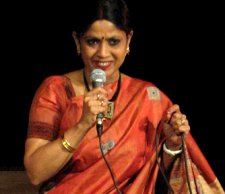 Nothing
succeeds like success. And behind the success there is always more than
100 percent, relentless hard work. When Bharatanatyam exponent Ananda
Shankar Jayant as a Nritya Choodamani of Sri Krishan Gana Sabha was
asked to convene the 28th (17-23 Dec 2008) and 29th Natya Kala Conference,
she took up the task with utter sincerity, leaving no stone unturned in
the process, devoting all her time and energy in conceptualizing the theme,
the speakers, dancers, critics, scholars, sponsors, giving minute attention
to several details, brainstorming her dancer friends, critics, scholars
and drawing up a plan which indeed covered a vast canvas, exploring several
myriad forms of the performing arts that have dealt with the epic Ramayana.
The conference concluded on the 23rd December and I am writing now, still
full of the happy memories and the magic, the spell under which we, who
attended the conference, are still relishing various highlights of this
memorable event. Nothing
succeeds like success. And behind the success there is always more than
100 percent, relentless hard work. When Bharatanatyam exponent Ananda
Shankar Jayant as a Nritya Choodamani of Sri Krishan Gana Sabha was
asked to convene the 28th (17-23 Dec 2008) and 29th Natya Kala Conference,
she took up the task with utter sincerity, leaving no stone unturned in
the process, devoting all her time and energy in conceptualizing the theme,
the speakers, dancers, critics, scholars, sponsors, giving minute attention
to several details, brainstorming her dancer friends, critics, scholars
and drawing up a plan which indeed covered a vast canvas, exploring several
myriad forms of the performing arts that have dealt with the epic Ramayana.
The conference concluded on the 23rd December and I am writing now, still
full of the happy memories and the magic, the spell under which we, who
attended the conference, are still relishing various highlights of this
memorable event.
From 1980,
when Dr. Padma Subrahmanyam at the invitation of late Sri Yagnaraman, the
secretary of Sri Krishna Gana Sabha, as a conevenor, initiated it for first
three years, to the 28th conference, I have been, barring a few years,
regularly attending it, gaining knowledge, listening to scholarly presentations
and watching demonstrations, enjoying the ‘Madras season.’ Several Nritya
Choodamani dancer awardees have convened the conference from year to year
and the conference has been a major landmark in the world of dance. From
abroad the NRIs make it a point to participate, attend it and from within
India several ‘regulars’ are seen there. They look forward to attending
this unique yearly get-together.
Ananda chose
Ramayana in Performing Arts as a theme, consulting Anita Ratnam and
senior dancers like Padma Subrahmanyam, Chitra Visweswaran and also others
including dance critic Leela Venkataraman and I. And we all appreciated
it. Various characters of Ramayana, how dancers in different dance forms
have handled them, how they have been perceived and also its interpretation
in contemporary Indian dance has been dealt with, how beyond the shores
of India in South East Asia and elsewhere Ramayana is staged, its global
impact et al generated quite an interest. Continuous correspondence
by e-mail and phone calls, persistent, persuasive, pleasant following up
have resulted in a rewarding exercise for Ananda and all the rasikas.
From the word
go to the final day, one saw excitement and eager crowds from 9.15 am till
1.30 pm attending the conference. Meticulous attention to décor,
backdrop (paintings by Pratima Sagar), designs, carefully removed banners,
which violated visual aesthetics, maintaining time - Ananda managed things
commendably. For past few years, the attendance at the conference, for
several reasons, had dwindled. This year it looked beyond doubt that the
conference had got ‘a shot in the arm’ and it had livened up. The atmosphere
was full of celebratory mood. There were M Madhu (cherial), Vishvanath
Reddy (kalamkari) and Khande Ramdas (leather puppets), all award winning
artisans who had put up the exhibition and there was a brisk sale of the
art objects available.
One of the
finest things planned by Ananda was the Natya Kala Conference Daily newsletter,
edited by Lalitha Venkat, the editor of www.narthaki.com, with daily report
of the conference by Pratima Sagar from Hyderabad. It contained a mine
of information, interviews, reviews, quotes, comments, announcements, photographs
and little known aspects of Ramayana. Very professional and brought out
dot on time. People made a bee line for it the moment they came to the
venue. Anita Ratnam supported the concept full heartedly. It gave introductions
to the participants, dancers, scholars, critics and provided a forum for
exchanging views. I have seen similar daily newsletters at the International
Film Festivals.
 Involving meticulous
research by Ananda, another major achievement was the Natya Kala Conference
souvenir, containing articles by the participants with brief introductions
to the theme of the paper and authors, well designed with apt drawings
and sketches by Pratima Sagar, who also edited it. It is indeed
a collector’s item. Sponsored by Vijay Nirman Company Private Ltd, Vishakhapatnam,
it has set a model for future souvenirs for such conferences. In the past
also souvenirs have been brought out, but in terms of its production values
and content, this souvenir stands out. It has brought Ramayana writings
up to date with excerpts from Ashok Banker’s Ramayana (Penguin Publications),
and reproductions of rare miniature paintings from the collection of art
historian Jagdish Mittal from Hyderabad. I read it from cover to cover
and it was refreshing as well rewarding to ‘re-visit’ Ramayana, not only
seeing the demonstrations on stage, but also the conceptualization by dancers,
scholars giving fresh insights into Ramayana.
Involving meticulous
research by Ananda, another major achievement was the Natya Kala Conference
souvenir, containing articles by the participants with brief introductions
to the theme of the paper and authors, well designed with apt drawings
and sketches by Pratima Sagar, who also edited it. It is indeed
a collector’s item. Sponsored by Vijay Nirman Company Private Ltd, Vishakhapatnam,
it has set a model for future souvenirs for such conferences. In the past
also souvenirs have been brought out, but in terms of its production values
and content, this souvenir stands out. It has brought Ramayana writings
up to date with excerpts from Ashok Banker’s Ramayana (Penguin Publications),
and reproductions of rare miniature paintings from the collection of art
historian Jagdish Mittal from Hyderabad. I read it from cover to cover
and it was refreshing as well rewarding to ‘re-visit’ Ramayana, not only
seeing the demonstrations on stage, but also the conceptualization by dancers,
scholars giving fresh insights into Ramayana.
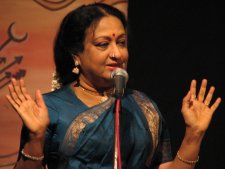 K
Jayakumar, Additional Chief Secretary, Govt. of Kerala, a lyricist, a painter,
playwright, and former joint secretary, Culture, Govt. of India, delivered
the keynote address emphasizing the family values reflected in the Ramayana.
Dr. Padma Subrahmanyam, with her inimitable exposition of selected
sequences from Ramayana and depicting navadha bhakti, the nine ways in
which different characters of Ramayana expressed their devotion to Lord
Rama, captivated the audience. It was followed by Dr. Prema Pandurang’s
discourse on Ramayana with comments and excellent art of oratory. The tone
was set and the mood was upbeat, promising rich fare from day to day. K
Jayakumar, Additional Chief Secretary, Govt. of Kerala, a lyricist, a painter,
playwright, and former joint secretary, Culture, Govt. of India, delivered
the keynote address emphasizing the family values reflected in the Ramayana.
Dr. Padma Subrahmanyam, with her inimitable exposition of selected
sequences from Ramayana and depicting navadha bhakti, the nine ways in
which different characters of Ramayana expressed their devotion to Lord
Rama, captivated the audience. It was followed by Dr. Prema Pandurang’s
discourse on Ramayana with comments and excellent art of oratory. The tone
was set and the mood was upbeat, promising rich fare from day to day.
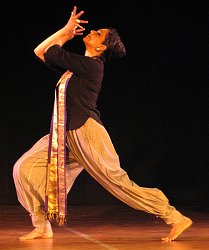 Anita
Ratnam opened the session next day with ‘Ahalya - Once again stone,’
her recent work-in-progress choreography in collaboration with dancer/choreographer,
Hari Krishnan, and costume designer Rex from Toronto, in what she prefers
to call Neo- Bharatam and contemporary genre. She posed questions: “How
do I tell Ahalya’s story? Through rhythm? Through abstraction of the Stonehenge
myth? Through vocal mnemonics? Through classical vocabularies? Through
props?” The explorations with classical vocabulary, then transiting through
abstraction and finally using the stones and reclining wooden yoga prop,
she conveyed several resonances, of stone as material, references to Pudumai
Pithan’s short story ‘Shaapa Vimochanam,’ a trailblazing story in the 1940s
, dwelling upon ‘the remarkable subversion of the original patriarchal
myth and a revolt by a woman in a man’s world.’ Ahalya felt free and less
constricted as stone. She was free to just be. In choosing to return to
what was widely thought of as a cursed shape, Ahalya chose to shun the
world of man and his whims. As a stone she could be among the elements.
No more would she be at the whim of Gautam or any man. Said Anita quoting
Michaelangelo, “I am not carving or sculpting; I am merely releasing the
excess stone from the image that already exists within.” Anita
Ratnam opened the session next day with ‘Ahalya - Once again stone,’
her recent work-in-progress choreography in collaboration with dancer/choreographer,
Hari Krishnan, and costume designer Rex from Toronto, in what she prefers
to call Neo- Bharatam and contemporary genre. She posed questions: “How
do I tell Ahalya’s story? Through rhythm? Through abstraction of the Stonehenge
myth? Through vocal mnemonics? Through classical vocabularies? Through
props?” The explorations with classical vocabulary, then transiting through
abstraction and finally using the stones and reclining wooden yoga prop,
she conveyed several resonances, of stone as material, references to Pudumai
Pithan’s short story ‘Shaapa Vimochanam,’ a trailblazing story in the 1940s
, dwelling upon ‘the remarkable subversion of the original patriarchal
myth and a revolt by a woman in a man’s world.’ Ahalya felt free and less
constricted as stone. She was free to just be. In choosing to return to
what was widely thought of as a cursed shape, Ahalya chose to shun the
world of man and his whims. As a stone she could be among the elements.
No more would she be at the whim of Gautam or any man. Said Anita quoting
Michaelangelo, “I am not carving or sculpting; I am merely releasing the
excess stone from the image that already exists within.”
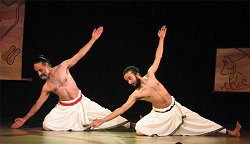 Slowly
and with care, the forum of Sri Krishna Gana Sabha is opening to the changes
that are sweeping over the dance world and new directions are being brought
to a mixed audience, which was further underlined by Navtej Singh Johar’s
contemporary work he presented with his partner Sudeep Nair on similar
vein, speaking and dwelling upon Dravya, Kaya, Bamboo, Bark and Earth indicating
Kodanda bow and Lakshmanrekha episodes, choreographing in a novel manner,
using yogasana vocabulary of physical traditions, inspired by working with
Chandralekha and using objects which have power, which can be revealed
by concentration and meditation! Slowly
and with care, the forum of Sri Krishna Gana Sabha is opening to the changes
that are sweeping over the dance world and new directions are being brought
to a mixed audience, which was further underlined by Navtej Singh Johar’s
contemporary work he presented with his partner Sudeep Nair on similar
vein, speaking and dwelling upon Dravya, Kaya, Bamboo, Bark and Earth indicating
Kodanda bow and Lakshmanrekha episodes, choreographing in a novel manner,
using yogasana vocabulary of physical traditions, inspired by working with
Chandralekha and using objects which have power, which can be revealed
by concentration and meditation!
The very fact
that die-hard traditional Kalakshetra maestros were watching it with rapt
attention and applauding these artists’ efforts is an indication of how
far the Indian classical dances have moved and travelled. The daily presence
of veteran Chinna Sarada, Jayalakshmi, Kunhiramans, CV Chandrasekhar, Dhananjayans
and young Kalakshetra students was heartwarming. Kalanidhi Narayanan, Mrs.
YG Parthasarathy, Chitra Visweswaran, VAK Ranga Rao, Padma Subrahmanyam,
Jaya Subramaniam (from Ottawa) and several NRIs including Hema Rajgopalan,
her daughter Krittika from Chicago, Anandavalli from Sydney, Pushkala from
London and several others warmed up the participating dancers and speakers.
 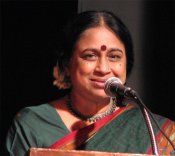 Gowri
Ramanarayan spoke on Sita-a spectrum and drew parallels with Drauapdi
and Meera, and read a contemporary poem on Sita. Her colleague from theatre,
Bala asked a question. “With all this awareness of the tyranny of patriarchy,
why do classical dancers perform these mythological characters only?” The
question was left hanging in the air as dancers, it appeared were in no
mood to quibble. Gowri
Ramanarayan spoke on Sita-a spectrum and drew parallels with Drauapdi
and Meera, and read a contemporary poem on Sita. Her colleague from theatre,
Bala asked a question. “With all this awareness of the tyranny of patriarchy,
why do classical dancers perform these mythological characters only?” The
question was left hanging in the air as dancers, it appeared were in no
mood to quibble.
Dr. Neena
Prasad presented excerpts from Sitayanam in Mohini Attam, which unfortunately
appeared not well structured. It would have had impact if Neena had interspersed
her talk with demonstrations.
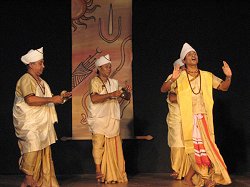 From
Kamalabari Sattra on Majuli Island, from Bhogpura Sattra from Jorhat and
other two Sattras, monasteries from Assam, a group of Sattriya dancers
gave an absorbing account of Ramayana in Ojhapali dance form, telling
the story of Sitaswayamvaram and Parasurama’s garva bhangam, when he got
enraged at Rama’s wielding and breaking the bow of Lord Shiva! Rarely seen
outside Assam, the Ojhapali Sattriya form sent by Sangeet Natak Akademi
aroused great interest amongst local dancers and scholars. Both Leela Venkataraman
and I had luckily seen the presentation of Bhogpur Sattradhikar at Guwahati
and were delighted that the form was brought to Chennai. From
Kamalabari Sattra on Majuli Island, from Bhogpura Sattra from Jorhat and
other two Sattras, monasteries from Assam, a group of Sattriya dancers
gave an absorbing account of Ramayana in Ojhapali dance form, telling
the story of Sitaswayamvaram and Parasurama’s garva bhangam, when he got
enraged at Rama’s wielding and breaking the bow of Lord Shiva! Rarely seen
outside Assam, the Ojhapali Sattriya form sent by Sangeet Natak Akademi
aroused great interest amongst local dancers and scholars. Both Leela Venkataraman
and I had luckily seen the presentation of Bhogpur Sattradhikar at Guwahati
and were delighted that the form was brought to Chennai.
In terms of
sheer variety of dance forms, sincere and conscious attempts on part of
the dancers, some of the stereotype characters like Soorpanakha (sic) and
Manthara were redeemed. Swapnasundari’s Soorpanakha left an indelible
impression and one would remember it for a long time. Her depiction of
Soorpanakha as per the Gyanpith awardee poet Viswanatha Sathyanarayana’s
Telugu work ‘Ramayana Kalpa Vrikshamu’ was spell binding. Taking few key
words, Swapna regaled the audience with her captivating abhinaya, dwelling
upon the metaphors and utpreksha, similes and literary conceits, singing
padyams, vasantatilaka chhanda and the like while portraying Soorpanakha
in colours and hues which changed for those present, the image of Soorpanakha
for ever from a hideous demoness to a voluptuous woman of beauty and sensitivity!
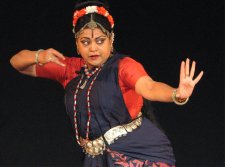 To
wit, paraphrasing the padyam ‘Virisi Manmadha-razu,’ she enacted with angikabhinaya:
it was as though the yawn of Manmatha which filled the sky, assumed
a female form; it was as though the bow of Manmatha broke with a crushing
sound which assumed female form; it was as though the ashes of Manmatha’s
body, when burnt by the third eye of Shiva, assumed the female form; it
was though Rati on the death of her husband, assumed the female form..Soorpankha’s
beauty was composed of these elements. She rolled her eyes in enticing
manner, while looking at Rama, at Lakshmana and at Sita, taking an overview
of the Panchavati dwelling and with mukhajabhinaya brought to life Soorpanakha
in a unique way. To
wit, paraphrasing the padyam ‘Virisi Manmadha-razu,’ she enacted with angikabhinaya:
it was as though the yawn of Manmatha which filled the sky, assumed
a female form; it was as though the bow of Manmatha broke with a crushing
sound which assumed female form; it was as though the ashes of Manmatha’s
body, when burnt by the third eye of Shiva, assumed the female form; it
was though Rati on the death of her husband, assumed the female form..Soorpankha’s
beauty was composed of these elements. She rolled her eyes in enticing
manner, while looking at Rama, at Lakshmana and at Sita, taking an overview
of the Panchavati dwelling and with mukhajabhinaya brought to life Soorpanakha
in a unique way.
One more instance:
Soorpanakha compliments Rama on his complexion sings: ‘Neyredu- padlerupu
neeli pagullar rangai,’ thou whose hues resembles the colour of jamun fruit,
splitting as they ripen on the tree! Allow me to catch you in the pallav
of my raiment, so you may not be hurt by falling to the ground!! Soorpanakha’s
growing desire for Rama is cleverly stalled by Rama asking her to reveal
her real form. Revealing her demonic form, she assures Rama that if her
husband does not obey she shall kill him!! Rama tell her that he will not
deviate from Dharma as he is ‘eka patnivrata’ and Soorpanakha retorts that
Kama, desire, is one of the Dharma also. The poet maintains consistency
in vesting Rama’s character with gentle humour throughout the sequence;
he manages to draw the reader’s full attention to the character of Soorpanakha
evoking sympathy for her in a seemingly unintentional way. Swapna succeeded
in bringing out Soorpanakha as a forthright woman capable of logical argument,
whose singular fault would appear to lie in her openly expressing a desire
for Rama. A woman scorned in love is a bad enemy but a woman scorned in
love and then pitied by her rival is the worst enemy imaginable.
Sita intervenes at the penultimate stage of the episode to tell Rama that
perhaps he should not judge Soorpanakha so harshly, for after all, which
woman can resist his awesome beauty? These words drive Soorpanakha into
a flying rage and she tries to attack Sita when Lakshmana disfigures her!
This was one of the highlights of the conference.
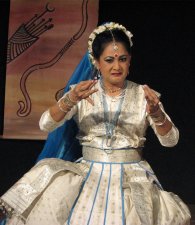 Manthara
also is depicted as a wicked woman. Sharodi Saikia, the Sattriya
exponent from Guwahati, drew her portrait in sympathetic manner. Also she
brought unusual variation and story element not known to many of us from
the Assamese Ramayana version of Madhav Kandoli of 14th Century AD. With
the text inspired by the work of Dr. Indira Goswami, the Gyanpith awardee,
Sharodi depicted an incident as follows: Not following Valmiki’s work blindly,
for entertainment of the common masses, Kandoli incorporates an interesting
episode. Having succeeded in her mission in converting Kaikeyi’s mind,
she harbors a secret ambition of ruling Ayodhya that Bharata would reward
her by accepting her as his mistress and a queen as soon as he becomes
a king.Although she was old and a hunchback, to lure Bharata she adorns
herself with royal ornaments and places a golden disc on her back to cover
her hunch! But she meets with punishment from Shatrughna for her audacity. Manthara
also is depicted as a wicked woman. Sharodi Saikia, the Sattriya
exponent from Guwahati, drew her portrait in sympathetic manner. Also she
brought unusual variation and story element not known to many of us from
the Assamese Ramayana version of Madhav Kandoli of 14th Century AD. With
the text inspired by the work of Dr. Indira Goswami, the Gyanpith awardee,
Sharodi depicted an incident as follows: Not following Valmiki’s work blindly,
for entertainment of the common masses, Kandoli incorporates an interesting
episode. Having succeeded in her mission in converting Kaikeyi’s mind,
she harbors a secret ambition of ruling Ayodhya that Bharata would reward
her by accepting her as his mistress and a queen as soon as he becomes
a king.Although she was old and a hunchback, to lure Bharata she adorns
herself with royal ornaments and places a golden disc on her back to cover
her hunch! But she meets with punishment from Shatrughna for her audacity.
Sharodi explained
that in later years this episode was frowned upon by the Assamese scholars
and authors. The later poets inspired from Kandoli avoided his episode
from their versions, though the great Saint poet Sankaradev kept the monumental
work intact. However, the audiences and the dancer agreed that Manthara
need not be depicted in this manner. Neither Soorpanakha nor Manthara in
present times are accepted by the dancers and audiences to be ridiculed
and there is a certain awarness amongst the artists and audiences to respect
women.
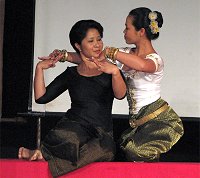 Another
highlight of the conference was Sophiline Shapiro, a dancer and
choreographer from Cambodia who with her disciple demonstrated the salient
features of Cambodian dances. The intimate relationship between sculpture
and dance, the living tradition of dance, influenced by Indian epic and
dance forms were well illustrated as also by screenings of the DVDs. Ananda
had met Fred Fremburg, an American opera conductor and deeply interested
artist in Cambodian dances in Phnom Penh when she had participated in a
Ramayana conference few years ago. Sophiline has been reconstructing
lost Cambodian dance tradition after the political upheaval in Cambodia.
Her all women troupe’s work is well known internationally. We had met during
a conference in Paris three years ago and I was delighted that she was
participating in this conference. Using traditional dance style, she brings
contemporary sensibilities to her choreography stressing upon harmony and
equanimity, using the symbol of Hari-Hara. Her participation added another
dimension to the conference. Another
highlight of the conference was Sophiline Shapiro, a dancer and
choreographer from Cambodia who with her disciple demonstrated the salient
features of Cambodian dances. The intimate relationship between sculpture
and dance, the living tradition of dance, influenced by Indian epic and
dance forms were well illustrated as also by screenings of the DVDs. Ananda
had met Fred Fremburg, an American opera conductor and deeply interested
artist in Cambodian dances in Phnom Penh when she had participated in a
Ramayana conference few years ago. Sophiline has been reconstructing
lost Cambodian dance tradition after the political upheaval in Cambodia.
Her all women troupe’s work is well known internationally. We had met during
a conference in Paris three years ago and I was delighted that she was
participating in this conference. Using traditional dance style, she brings
contemporary sensibilities to her choreography stressing upon harmony and
equanimity, using the symbol of Hari-Hara. Her participation added another
dimension to the conference.
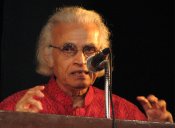 To
supplement Sophiline’s presentation, I had chosen to present Kechak dance
of Bali and to show how Indian Diaspora in America has worked with Balinese
dancers using traditional Bharatanatyam. I screened 2 key excerpts: one
of Dewa Putera of Chudamani Dance Company of Ubud, Bali and Minneapolis
based Ragamala Dance Company of Ranee Ramaswamy performing at the International
Ramayana Festival in Bali in 2006 and another of Ragamala’s group work
presented with American and Balinese dancers using Kechak dance form at
Sculpture Garden. Dr. Pappu Venugopal Rao very kindly edited the two DVDs
for my presentation. Hema Rajgopalan and her company led by her daughter
Krittika had worked with 100 young musicians in an opera on Ramayana two
years ago. These attempts are generally not known in India. To
supplement Sophiline’s presentation, I had chosen to present Kechak dance
of Bali and to show how Indian Diaspora in America has worked with Balinese
dancers using traditional Bharatanatyam. I screened 2 key excerpts: one
of Dewa Putera of Chudamani Dance Company of Ubud, Bali and Minneapolis
based Ragamala Dance Company of Ranee Ramaswamy performing at the International
Ramayana Festival in Bali in 2006 and another of Ragamala’s group work
presented with American and Balinese dancers using Kechak dance form at
Sculpture Garden. Dr. Pappu Venugopal Rao very kindly edited the two DVDs
for my presentation. Hema Rajgopalan and her company led by her daughter
Krittika had worked with 100 young musicians in an opera on Ramayana two
years ago. These attempts are generally not known in India.
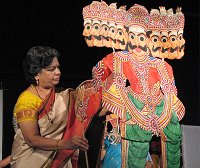 VR
Devika, in her story telling presentation of Ramayana, succeeded in
having more than 200 school children, for the first time in Sri Krishna
Gana Sabha auditorium, answering and responding to several interesting
questions. On screen she projected the map of India and the route of Ramayana
in different states. Using the leather puppets with characters of Ramayana,
the puppeteers told the story, and three male folk dancers performed and
sang in the front. It was such a fascinating sight and the auditorium reverberated
with joyous sound of children. This was another highlight of the conference. VR
Devika, in her story telling presentation of Ramayana, succeeded in
having more than 200 school children, for the first time in Sri Krishna
Gana Sabha auditorium, answering and responding to several interesting
questions. On screen she projected the map of India and the route of Ramayana
in different states. Using the leather puppets with characters of Ramayana,
the puppeteers told the story, and three male folk dancers performed and
sang in the front. It was such a fascinating sight and the auditorium reverberated
with joyous sound of children. This was another highlight of the conference.
One only regretted
that children and schools were not informed about the Little Ballet Troupe’s
performance of Ramayana, in which human characters dance as puppets, when
during a fair the puppet show is mounted. Choreographed by late Shanti
Bardhan in the fifties, it is a remarkable production and a landmark in
the history of dance. Very original and brilliant!! Sangeet Natak Akademi
had sponsored its presentation.
The conference
gained momentum with the unfolding of various facets of Ramayana in different
dance styles. Prof. CV Chandrasekhar and his daughter Manjari recreated
using Bharatanatyam style, the nostalgia of Tulsidasa’s Ramacharitamanas,
as they were in Varanasi, Benaras, for more than 25 years and were seeped
into the magic and music of the chaupais, which is a shared tradition in
North India. Sonal Mansingh also presented Sita Swayamvara episode
using the text of Tulsidasa’s Ramacharitamanas in Odissi, to the evocative
singing of Bankim Sethi.
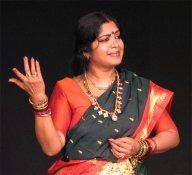 Alekhya
Punjla, the dusky doe-eyed Kuchipudi dancer from Hyderabad, sketched
the portrait of Mandodari, the wife of Ravana. The traditional Kuchipudi
Mandodari shabdam, with vachikabinaya, the dialogue, a salient feature
of Kuchipudi dance-drama was presented charmingly. Using contemporary poet
Mallemala’s text Alekhya’s presentation introduced an interesting element
not generally known about Hanuman mistaking Mandodari as Sita. Since he
had not seen Sita, he seeing the beauty of Mandodari mistakes her for Sita.
But soon realizes that it is Ravana’s wife. Mandodari’s final anguish and
heart-rending vilap, crying, knowing fully well that Ravana will be killed
at the hands of Lord Rama, was enacted poignantly and with the dignity
becoming the wife of a great King. Alekhya
Punjla, the dusky doe-eyed Kuchipudi dancer from Hyderabad, sketched
the portrait of Mandodari, the wife of Ravana. The traditional Kuchipudi
Mandodari shabdam, with vachikabinaya, the dialogue, a salient feature
of Kuchipudi dance-drama was presented charmingly. Using contemporary poet
Mallemala’s text Alekhya’s presentation introduced an interesting element
not generally known about Hanuman mistaking Mandodari as Sita. Since he
had not seen Sita, he seeing the beauty of Mandodari mistakes her for Sita.
But soon realizes that it is Ravana’s wife. Mandodari’s final anguish and
heart-rending vilap, crying, knowing fully well that Ravana will be killed
at the hands of Lord Rama, was enacted poignantly and with the dignity
becoming the wife of a great King.
 And
when you have Margi Madhu in Kudiyattam, portraying Hanuman, you
are spellbound by the sheer artistry of the actor and the form. With two
mizhavu drummers and a lady accompanist playing cymbals, Madhu sitting
on a stool, delivered Sanskrit text, bringing to life the character of
Hanuman and also evoked hasya rasa. The audience was under his spell.
Madhu observes in his article ‘Living with the lores’: ‘Kudiyattam uses
a recapitulation technique known as Nirvahanam which causes elaboration
of the act. Whenever the extension is needed the story will be freezed
and the actor with his imagination reverts to the epic and poetry what
he needs to elaborate. At the same time we see two texts of Ramayana which
have totally different versions of the stories. In Ascharyachoodamani play,
Ravana disguises as Maya Rama and takes Sita away. But in Abhisheka’s play,
Ravana disguises as a monk and kidnaps Sita. Whatever is the story, Kudiyattam
is only for enactment, so the story line is not important as is the manner
in which it is enacted with imagination.’ And
when you have Margi Madhu in Kudiyattam, portraying Hanuman, you
are spellbound by the sheer artistry of the actor and the form. With two
mizhavu drummers and a lady accompanist playing cymbals, Madhu sitting
on a stool, delivered Sanskrit text, bringing to life the character of
Hanuman and also evoked hasya rasa. The audience was under his spell.
Madhu observes in his article ‘Living with the lores’: ‘Kudiyattam uses
a recapitulation technique known as Nirvahanam which causes elaboration
of the act. Whenever the extension is needed the story will be freezed
and the actor with his imagination reverts to the epic and poetry what
he needs to elaborate. At the same time we see two texts of Ramayana which
have totally different versions of the stories. In Ascharyachoodamani play,
Ravana disguises as Maya Rama and takes Sita away. But in Abhisheka’s play,
Ravana disguises as a monk and kidnaps Sita. Whatever is the story, Kudiyattam
is only for enactment, so the story line is not important as is the manner
in which it is enacted with imagination.’
Madhu enacted
the role of Hanuman with consummate artistry. The ‘stobha,’
establishing the character in Kudiyattam, a convention, was impressively
employed.
It is worth
to learn that Madhu along with his elder brother Margi Narayanan has been
working towards bringing back audiences to an art that would have become
extinct. Madhu is a Professor at the Theatre Department of Shri Sankaracharya
University of Sanskrit (Kalady, Kerala), runs Nepathya Institute, a project
of his wife Dr. Indu G Nair, a Nangiarkoothu exponent, at Aluva. It indeed
was a rare presentation; even though brief, it engaged immediate attention
of the audience the moment the two mizhavu (the copper drum) players played
on the drums seated at the back of the performer. Each day the conference
threw up as it were gems of demonstrations and novel approaches to Ramayana.
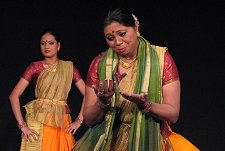 From
Mumbai, Kathak exponent and actor Rajashree Shirke and her troupe
captivated the audience with their spirited Ravan- Mandodari samvad. Employing
the tradition of story telling, the Kathakar paddhati prevalent in Maharashtra
with dramatic impact, Rajashree and her dancers won over the audiences
with their excellent presentation. The use of tatkar, the footwork of Kathak,
the dancers turning into various characters, and the battle, the duel between
Ravana and Rama, were not only gripping but electrifying. The well known
sadara of Bindadin Maharaj ‘Shesh fana dagamagyo’ danced by Rajashree begging
Ravana not to fight with Lord Rama, indeed was again heart-rending, and
very moving. Rajashree’s son who composed the music also used the band
dramatically. From
Mumbai, Kathak exponent and actor Rajashree Shirke and her troupe
captivated the audience with their spirited Ravan- Mandodari samvad. Employing
the tradition of story telling, the Kathakar paddhati prevalent in Maharashtra
with dramatic impact, Rajashree and her dancers won over the audiences
with their excellent presentation. The use of tatkar, the footwork of Kathak,
the dancers turning into various characters, and the battle, the duel between
Ravana and Rama, were not only gripping but electrifying. The well known
sadara of Bindadin Maharaj ‘Shesh fana dagamagyo’ danced by Rajashree begging
Ravana not to fight with Lord Rama, indeed was again heart-rending, and
very moving. Rajashree’s son who composed the music also used the band
dramatically.
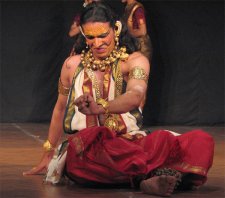 And
like icing on the cake came the excerpts from Rukmini Devi’s dance-dramas
from Kalakshetra. Vastly gifted Sheejith Krishna, with a commanding
stage presence displayed Ravana’s facets as he has studied from his senior
predecessors like Janardhanan and Balagopalan. How Rukmini Devi used Kathakali
technique and also drew inspiration for costume of Ravana and other facts
were brought to the notice of the audience by Sheejith. In particular,
the spirited dialogue between Ravana and Sita from Valmiki’s Ramayana brought
happy memories of Rukmini Devi’s genius in etching portraits of both Ravana
and Sita. Though I have seen Rukmini Devi’s Ramayana dance-drama
series many times, I must confess I had forgotten many salient features
and like many others present marvelled at Rukmini Devi’s approach and vision.
This re-visiting of Ramayana was like a bonus. The high standard
of Kalakshetra was writ large on each scene, be it costumes, music, dance
and abhinaya. Such a legacy of rare aesthetics will always keep her productions
a notch above other dance-drama productions of Ramayana. Ananda is a product
of Kalakshetra and it was a befitting gesture on her part and artists from
Kalakshetra to showcase Rukmini Devi’s choreography of Ramayana. Those
whoever has seen the series and those who saw for the first time indeed
expressed great pleasure and unalloyed joy witnessing the sequences. Sheejith’s
analysis and deep study are praiseworthy. And
like icing on the cake came the excerpts from Rukmini Devi’s dance-dramas
from Kalakshetra. Vastly gifted Sheejith Krishna, with a commanding
stage presence displayed Ravana’s facets as he has studied from his senior
predecessors like Janardhanan and Balagopalan. How Rukmini Devi used Kathakali
technique and also drew inspiration for costume of Ravana and other facts
were brought to the notice of the audience by Sheejith. In particular,
the spirited dialogue between Ravana and Sita from Valmiki’s Ramayana brought
happy memories of Rukmini Devi’s genius in etching portraits of both Ravana
and Sita. Though I have seen Rukmini Devi’s Ramayana dance-drama
series many times, I must confess I had forgotten many salient features
and like many others present marvelled at Rukmini Devi’s approach and vision.
This re-visiting of Ramayana was like a bonus. The high standard
of Kalakshetra was writ large on each scene, be it costumes, music, dance
and abhinaya. Such a legacy of rare aesthetics will always keep her productions
a notch above other dance-drama productions of Ramayana. Ananda is a product
of Kalakshetra and it was a befitting gesture on her part and artists from
Kalakshetra to showcase Rukmini Devi’s choreography of Ramayana. Those
whoever has seen the series and those who saw for the first time indeed
expressed great pleasure and unalloyed joy witnessing the sequences. Sheejith’s
analysis and deep study are praiseworthy.
Ananda, wanting
to explore other areas of Ramayana in different genres like traditions
of bhajan singing in Maharashtra, introduced Raghunath Khandelkar,
abhang vocalists to render songs extolling virtues of Lord Rama. Well known
Carnatic musician, composer, singer OS Arun rendered Tulsidasa’s bhajans
in his inimitable way and melodious voice. Who can forget ‘Thumaki chalat
Ramachandra bajat painjania?’ or ‘Shri Ramachandra kripalubhajamana,’ the
evergreen compositions? Venu Madhav’s Ramayana Sankeertanam was another
interesting rendition. However, since there was spilling over of the time
and singing being scheduled towards the end, the audience participation
was limited. If they were scheduled before dance-demonstrations, there
would have been more response.
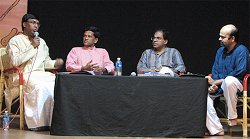 The
session on Gods and the Musicians, moderated by classical pianist
and composer Anil Srinivasan added another dimension to the conference.
Neyveli Santanagopalan, Vichitra Veena player Ravi Kiran, and Dr. Sriram
Parasuram spoke eloquently on the spiritual significance of music in the
lives of musicians. Anil’s summing up was apt: “We are never divorced from
religion, spirituality and entertainment which are an extension of god-music-man
as three corners of a triangle. As a matter of fact the devotional aspect
of the music with the content of music seems inseparable. And therefore
any detailed deliberation would end in accepting the fact that music must
reign supreme. And give the rasikas ‘ananda which is like brahmanandasahodara.” The
session on Gods and the Musicians, moderated by classical pianist
and composer Anil Srinivasan added another dimension to the conference.
Neyveli Santanagopalan, Vichitra Veena player Ravi Kiran, and Dr. Sriram
Parasuram spoke eloquently on the spiritual significance of music in the
lives of musicians. Anil’s summing up was apt: “We are never divorced from
religion, spirituality and entertainment which are an extension of god-music-man
as three corners of a triangle. As a matter of fact the devotional aspect
of the music with the content of music seems inseparable. And therefore
any detailed deliberation would end in accepting the fact that music must
reign supreme. And give the rasikas ‘ananda which is like brahmanandasahodara.”
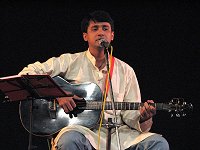 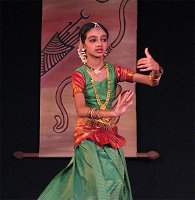 This
was not enough for the convener. Therefore she had included the next generation
participants like Mahati Kannan, 10 year old grand niece of Padma
Subrahmanyam in Bhavayami raghuramam composition of Swati Tirunal. She
stole the hearts of all present with her artistry. She is bound to go places.
The confidence and natural grace, born to the manner Mahati has head start
advantages with an aunt like Padma Subrahmanyam, parents like Kannan and
mother Gayatri who is a dancer and singer. For her generation she provides
a role model. Anita Ratnam had recommended a young guitar player Vedant
Bharadwaj who strummed on guitar, Rama bhajans of Kabir and Tulsidas.
He loves classical music and feels that through popular bhajans and instrument
like guitar, he can get his peers interested in classical music. The inclusion
of both these artists was a brilliant idea. This
was not enough for the convener. Therefore she had included the next generation
participants like Mahati Kannan, 10 year old grand niece of Padma
Subrahmanyam in Bhavayami raghuramam composition of Swati Tirunal. She
stole the hearts of all present with her artistry. She is bound to go places.
The confidence and natural grace, born to the manner Mahati has head start
advantages with an aunt like Padma Subrahmanyam, parents like Kannan and
mother Gayatri who is a dancer and singer. For her generation she provides
a role model. Anita Ratnam had recommended a young guitar player Vedant
Bharadwaj who strummed on guitar, Rama bhajans of Kabir and Tulsidas.
He loves classical music and feels that through popular bhajans and instrument
like guitar, he can get his peers interested in classical music. The inclusion
of both these artists was a brilliant idea.
Another interesting
feature was screening of animation film ‘Sita sings the blues’ of
New York based film maker Nina Paley. The witty interpretations of Ramayana
do not hurt anyone. As a matter of fact, one notices Nina’s metaphorical
adaptation of Ramayana into her own story. The images from miniature paintings
to animated images and the singing of the blues haunt the onlookers as
Sita adapts them into her experiences. It was screened at Alliance Francaise
de Chennai and drew a section of the audience who enjoyed the catholic
approach to Ramayana in many media, including films. As Ananda had observed
in her address, when Ramanand Sagar’s television serial on Ramayana was
telecast the entire nation watched it. The tale of Ramayana adapts and
renews itself in contemporary times. The blackberry and i-phone toting
executive, the video game punching youngster, the animator, the film maker
and the TV soap creators alike are all inspired by the Ramayana.
 All
good things have to come to an end. Dance critic Leela Venkataraman
in her concluding remarks spoke eloquently on the several aspects of Ramayana
as presented in the conference, and also covered in her excellent article
Ramayana, a Pan Asian Tradition. She shared with the audiences her own
unforgettable moments of seeing the legendary Kudiyattam artist late Ammanur
Madhava Chakyar’s last performance in New Delhi at the National School
of Drama. Her vast exposure to the performing arts, regularly writing for
The Hindu and wonderful gift of articulating her transparent joy with readers
and rasikas was evident in her observations. All
good things have to come to an end. Dance critic Leela Venkataraman
in her concluding remarks spoke eloquently on the several aspects of Ramayana
as presented in the conference, and also covered in her excellent article
Ramayana, a Pan Asian Tradition. She shared with the audiences her own
unforgettable moments of seeing the legendary Kudiyattam artist late Ammanur
Madhava Chakyar’s last performance in New Delhi at the National School
of Drama. Her vast exposure to the performing arts, regularly writing for
The Hindu and wonderful gift of articulating her transparent joy with readers
and rasikas was evident in her observations.
The valedictory
address by Dr. Paula Richman, the Danforth Professor of South Asian
Religion at Oberlin College (Cleveland, Ohio, USA), emphasized on how Ramayana
has not only penetrated into the masses from times immemorial but also
that which has evolved and moulded itself as a metaphor in contemporary
cultural spaces. I would like to quote from Leela Venkataraman’s summing
up: “Dr Paula Richman’s extended study and research across the world show
how the epic becomes witty and localized, filling in parts where originally
there was silence. Here was a dialogue between Soorpanakha and Sita who
recognize each other during the latter’s exile in the forest and that Sita
is known as the world’s first single parent! Ravana’s multiple heads replaced
by the present day political villains, Urmila symbolized with the contemporary
working woman away from her husband and the like, which was at once funny
but also thought provoking. I recommend all who have the Natya Kala Conference
souvenir, to read Dr. Paula Richman’s translation of the article ‘Clothing
matters’ by Ranganayaki Thatham (1905-1986) who wrote under the pen name
of Kumudini published in Ananda Vikatan in 1934, and deals with an account
of Sita’s life in a joint family spent at Ayodhya.”
On behalf of
all, Padma Subrahmanyam honoured Ananda Shankar Jayant, the convener, with
a shawl in appreciation of this conference. There was a lunch at the end
of the conference on the venue of Krishna Gana Sabha and it seemed the
participants did not want to leave the magic created by the conference.
The conference indeed succeeded in making the participants exchange views
after the sessions. I suggest the convener should announce in advance about
the lunch every day by buying the coupons, so that those who wish to ‘hang
on’ and talk can do so. Earlier at one of the conferences, Anita Ratnam
and I had worked out that strategy, which was very successful. It can be
repeated. Since everyday there were nearly four papers/presentations, the
time constraints were felt. Many who wished to attend other presentations
found it difficult to carry on till 1 or 1.30 pm. It would help if there
is less overcrowding of presentations. In any case, the conference was
a very rewarding and a memorable experience.
 Dr.
Sunil Kothari, dance historian, scholar, author, is a renowned dance critic,
having written for The Times of India group of publications for more than
40 years. He is a regular contributor to Dance Magazine, New York. Dr.
Kothari is a globetrotter, attending several national, international dance
conferences and dance festivals. He has to his credit more than 14 definitive
works on Indian classical dance forms. Kothari was a Fulbright Professor
and has taught at the Dance Department, New York University; has lectured
at several Universities in USA, UK, France, Australia, Indonesia and Japan.
He has been Vice President of World Dance Alliance Asia Pacific (2000-2008)
and is Vice President of World Dance Alliance Asia Pacific India chapter,
based in New Delhi. A regular contributor to www.narthaki.com, Dr Kothari
is honored by the President of India. Dr.
Sunil Kothari, dance historian, scholar, author, is a renowned dance critic,
having written for The Times of India group of publications for more than
40 years. He is a regular contributor to Dance Magazine, New York. Dr.
Kothari is a globetrotter, attending several national, international dance
conferences and dance festivals. He has to his credit more than 14 definitive
works on Indian classical dance forms. Kothari was a Fulbright Professor
and has taught at the Dance Department, New York University; has lectured
at several Universities in USA, UK, France, Australia, Indonesia and Japan.
He has been Vice President of World Dance Alliance Asia Pacific (2000-2008)
and is Vice President of World Dance Alliance Asia Pacific India chapter,
based in New Delhi. A regular contributor to www.narthaki.com, Dr Kothari
is honored by the President of India.
|



 Alekhya
Punjla, the dusky doe-eyed Kuchipudi dancer from Hyderabad, sketched
the portrait of Mandodari, the wife of Ravana. The traditional Kuchipudi
Mandodari shabdam, with vachikabinaya, the dialogue, a salient feature
of Kuchipudi dance-drama was presented charmingly. Using contemporary poet
Mallemala’s text Alekhya’s presentation introduced an interesting element
not generally known about Hanuman mistaking Mandodari as Sita. Since he
had not seen Sita, he seeing the beauty of Mandodari mistakes her for Sita.
But soon realizes that it is Ravana’s wife. Mandodari’s final anguish and
heart-rending vilap, crying, knowing fully well that Ravana will be killed
at the hands of Lord Rama, was enacted poignantly and with the dignity
becoming the wife of a great King.
Alekhya
Punjla, the dusky doe-eyed Kuchipudi dancer from Hyderabad, sketched
the portrait of Mandodari, the wife of Ravana. The traditional Kuchipudi
Mandodari shabdam, with vachikabinaya, the dialogue, a salient feature
of Kuchipudi dance-drama was presented charmingly. Using contemporary poet
Mallemala’s text Alekhya’s presentation introduced an interesting element
not generally known about Hanuman mistaking Mandodari as Sita. Since he
had not seen Sita, he seeing the beauty of Mandodari mistakes her for Sita.
But soon realizes that it is Ravana’s wife. Mandodari’s final anguish and
heart-rending vilap, crying, knowing fully well that Ravana will be killed
at the hands of Lord Rama, was enacted poignantly and with the dignity
becoming the wife of a great King.